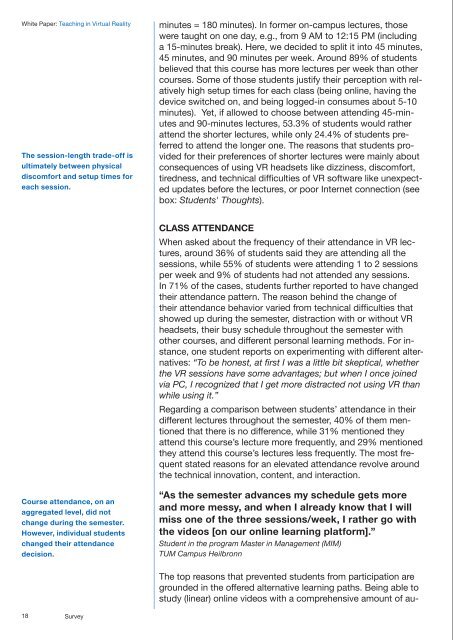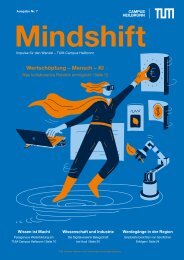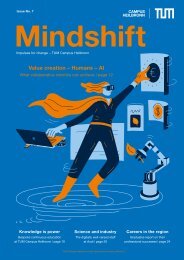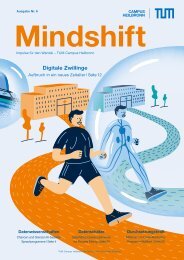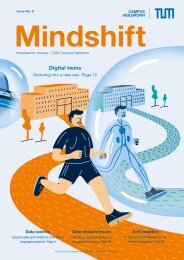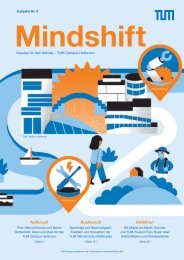You also want an ePaper? Increase the reach of your titles
YUMPU automatically turns print PDFs into web optimized ePapers that Google loves.
White Paper: <strong>Teaching</strong> in <strong>Virtual</strong> <strong>Reality</strong><br />
The session-length trade-off is<br />
ultimately between physical<br />
discomfort and setup times for<br />
each session.<br />
minutes = 180 minutes). In former on-campus lectures, those<br />
were taught on one day, e.g., from 9 AM to 12:15 PM (including<br />
a 15-minutes break). Here, we decided to split it into 45 minutes,<br />
45 minutes, and 90 minutes per week. Around 89% of students<br />
believed that this course has more lectures per week than other<br />
courses. Some of those students justify their perception with relatively<br />
high setup times for each class (being online, having the<br />
device switched on, and being logged-in consumes about 5-10<br />
minutes). Yet, if allowed to choose between attending 45-minutes<br />
and 90-minutes lectures, 53.3% of students would rather<br />
attend the shorter lectures, while only 24.4% of students preferred<br />
to attend the longer one. The reasons that students provided<br />
for their preferences of shorter lectures were mainly about<br />
consequences of using VR headsets like dizziness, discomfort,<br />
tiredness, and technical difficulties of VR software like unexpected<br />
updates before the lectures, or poor Internet connection (see<br />
box: Students' Thoughts).<br />
tomatically corrected quizzes online in combination with comprehensive<br />
exercise sessions in video conferencing software better<br />
meets the learning style of some students. This emphasizes the<br />
importance of providing alternative learning paths in VR-based<br />
online lecturers.<br />
PERCEIVED BENEFITS<br />
Besides the direct link between the use of VR and the attendance<br />
rate, we also surveyed the perceived VR benefits by<br />
students (Figure 7). Throughout the semester, the feature to chitchat<br />
with classmates gained importance. This reflects the importance<br />
of social learning. Rather than being left alone at home, VR<br />
enables at least some form of informal interaction with others.<br />
The immersive classroom experience was equally valued but<br />
stayed constant over time.<br />
Social learning is among the<br />
most important features and<br />
perspectives of VR-supported<br />
online teaching.<br />
Course attendance, on an<br />
aggregated level, did not<br />
change during the semester.<br />
However, individual students<br />
changed their attendance<br />
decision.<br />
CLASS ATTENDANCE<br />
When asked about the frequency of their attendance in VR lectures,<br />
around 36% of students said they are attending all the<br />
sessions, while 55% of students were attending 1 to 2 sessions<br />
per week and 9% of students had not attended any sessions.<br />
In 71% of the cases, students further reported to have changed<br />
their attendance pattern. The reason behind the change of<br />
their attendance behavior varied from technical difficulties that<br />
showed up during the semester, distraction with or without VR<br />
headsets, their busy schedule throughout the semester with<br />
other courses, and different personal learning methods. For instance,<br />
one student reports on experimenting with different alternatives:<br />
“To be honest, at first I was a little bit skeptical, whether<br />
the VR sessions have some advantages; but when I once joined<br />
via PC, I recognized that I get more distracted not using VR than<br />
while using it.”<br />
Regarding a comparison between students’ attendance in their<br />
different lectures throughout the semester, 40% of them mentioned<br />
that there is no difference, while 31% mentioned they<br />
attend this course’s lecture more frequently, and 29% mentioned<br />
they attend this course’s lectures less frequently. The most frequent<br />
stated reasons for an elevated attendance revolve around<br />
the technical innovation, content, and interaction.<br />
“As the semester advances my schedule gets more<br />
and more messy, and when I already know that I will<br />
miss one of the three sessions/week, I rather go with<br />
the videos [on our online learning platform].”<br />
Student in the program Master in Management (MIM)<br />
TUM Campus Heilbronn<br />
The top reasons that prevented students from participation are<br />
grounded in the offered alternative learning paths. Being able to<br />
study (linear) online videos with a comprehensive amount of au-<br />
“Just 'doing something cool in VR' is beneficial at the<br />
beginning but not sustainable.”<br />
Prof. Dr. David Wuttke, Center for Digital Transformation, TUM Campus Heilbronn<br />
The aspect of learning about new technologies increased in<br />
importance and became the top benefit at the end of the semester.<br />
In contrast, reduced monotony as a benefit became less<br />
relevant. This captures the fact that the aspect of novelty and<br />
the initial excitement wear off rapidly. When the initial excitement<br />
ends, it is important to have established long-term benefits of<br />
VR. Extrapolating this trend, however, the initial excitement may<br />
be enough to overcome some technical struggles that occur particularly<br />
at the beginning of such a teaching project.<br />
Figure 7: PERCEIVED BENEFITS OF VR BY STUDENTS<br />
Perceived Benefits of VR by Students<br />
30%<br />
25%<br />
20%<br />
15%<br />
10%<br />
5%<br />
0%<br />
Chit-chatting<br />
with<br />
classmates<br />
Immersive<br />
classroom<br />
experience<br />
Mid-term survey<br />
Learning about<br />
new<br />
technologies<br />
Reduced<br />
monotony<br />
End-of-semester survey<br />
When the initial excitement<br />
ends, it is important to have<br />
established long-term benefits<br />
of VR.<br />
Spatial<br />
communication<br />
18 Survey<br />
Survey 19


